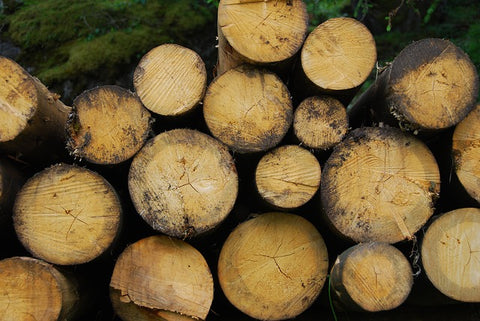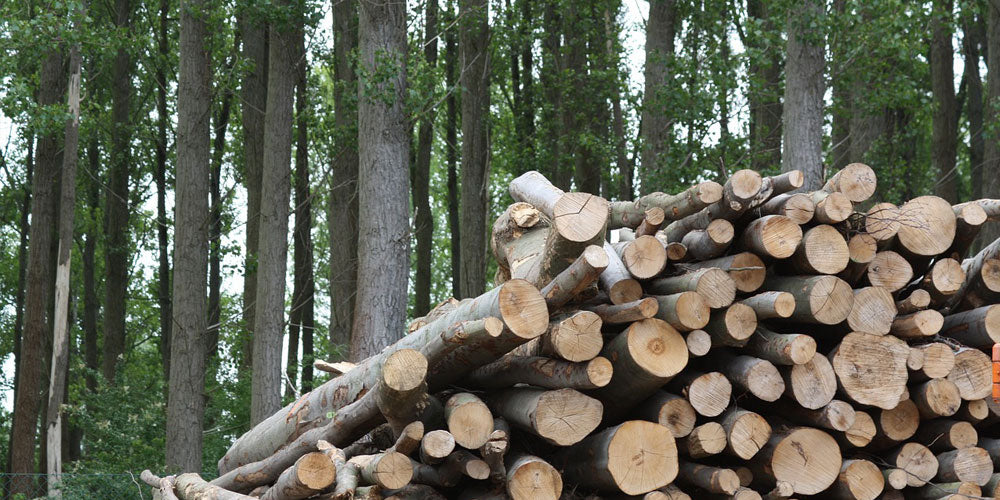How does biomass work?

Throughout the life of a plant, for it to grow, it requires a couple of crucial factors, like water, sunlight, and nutrients from the soil. If correct conditions are met, the plant will begin to grow, sprouting leaves over time. Leaves are essential - they absorb the energy from the Sun through photosynthesis, not only converting it into usable energy that can allow the plant to grow even further but also storing the energy away within the plant where it remains until the plant dies and decomposes.
Biomass isn't just plant-life, it encompasses any living creature! For example, recently deceased animals can be used as biomass fuel, this is because animals also require energy, which is obtained through eating other living organisms. You only need to take a quick glance at the food chain to understand how this works, herbivores eat plants, and carnivores eat the herbivores which ate the plants - it's as simple as that! Biomass also extends to faeces, human, animal; you name it, it can be used because it is all organic matter.
When a substantial amount of biomass is gathered, it can be used as fuel directly by combustion (e.g., materials like wood), or be utilised further to produce more efficient fuels, such as charcoal. Another common form the biomass fuel takes is gas - as organic matter decays and rots, gas is produced as a by-product. This gas can be captured, cleaned and used just like you would in a gas oven.
What is biomass energy?

When a plant dies, the chemical energy stored within the plant remains there. This is the basics of biomass – it is merely the energy stored away within organic matter. As mentioned above, it's not just limited to plants – since animals require energy to grow just as plants do, the animal matter is a perfect source of biopower - it's just obtained differently.
Let's take a look at a tree as an example! If we had a fully grown tree and we cut it down, we could then use the wood as fuel. When the wood is being burned, the chemical energy is released in the form of heat, which can then be utilised. However, unlike coal or other fossil fuels, biomass is carbon-neutral! This means that CO2 emissions from biomass are part of a short cycle and do not increase the net amount of CO2 in the atmosphere. This is because the trees absorb CO2 throughout their lifespan and when they're burned, it is released. The released CO2 is then re-absorbed by other trees, creating a cycle. However, it is important to note that this only works if the trees are managed sustainably. This process of harvesting and re-growth, if managed correctly, creates a near limitless source of renewable energy.
Other methods to obtain biomass energy
- Decomposition - biomass can be derived from anything that can decay and rot. This includes, and is not limited to, human and animal waste (including the animals themselves), and garbage. This energy is obtained through methane gas (also known as biogas) that is produced during the process of decomposition. The methane can then be captured using a micro-turbine, which converts the biogas into electricity.
- Fermentation – crops that contain significant amounts of sugars like corn, or more obviously sugar cane, can be used to produce ethanol through the process of gasification.
Types of biomass
Biomass takes a variety of forms, depending on the material that is being used to create the fuel. We know that trees can be used to create biomass fuel, but what are the other forms of fuel produced using biopower? Below is a list of the types of biomass and what sort of fuels it creates.
- Crops – as mentioned above, crops can be used to create biofuels. The plants absorb energy from the Sun through photosynthesis, they're then harvested, and the energy from the Sun, which they’ve collected throughout their lifetime, remains within the crop and can be extracted via burning, decomposition, and fermentation.
- Wood – this is probably the most obvious of the biofuels - wood has been used as fuel since the discovery of fire. This is an excellent example of biofuel, and it's as simple as lighting a fire and putting wood on it. Wood can also be used to create charcoal which is an even better fuel than just burning the wood.
- Landfill gas – you've probably heard that landfills produce large amounts of methane gas and are often prone to being set on fire; they’re also well known for damaging the environment. The gas that is produced can be harvested and used in place of traditional gases. Landfills produce methane because bacteria and fungi eat away at the waste causing them to rot and decay. Due to new regulations, landfills are required to collect the methane gas, the gas is then purified and supplied to utility companies.
- Garbage – people have been burning trash for a long time. What is new, however, is using garbage to create electricity; places that use waste to produce electricity are called waste-to-energy plants. This puts an otherwise wasted source of energy to good use rather than it just sitting there damaging the environment. However, the result of burning garbage can produce some unwanted by-products which must be cleaned before being released into the atmosphere and is currently more expensive than coal. This method for generating electricity reduces about 60 – 90% of the garbage that would usually just end up in landfills.
- Alcohol fuels – alcohol is typically a by-product of fermentation process, and it being an incredibly flammable makes it an ideal candidate for a biofuel. Wheat, corn and other such crops can be used to produce liquid fuels which include and is not limited to ethanol and methanol.
Is biomass renewable?
This is a big question to answer, is biomass energy renewable? The answer isn't actually that straightforward. Biomass technically is renewable; however, it is only renewable if we make it so. If the resources we use are not being replaced, that would make the biomass non-renewable. Let's look at an example - if we cut down 100 trees to use as biomass fuel, this makes us 100 trees down. However, if for every 100 trees we cut down, we planted 100 new trees, it would make it a renewable energy source because we will be able to use the new trees as a biopower in the future. Having that relationship with the way we see these resources is an excellent step in the right direction. But let's say we'd planted 150 trees for every 100 we cut down - over time we will not only have more trees, but the environment would benefit too - biomass is carbon-neutral, which means that if we plant more trees than we take for fuel, then more CO2 would be absorbed from the atmosphere than we pump into it, which would also help to combat emissions produced during transportation of biomass materials.
Leftover or unwanted food can also be used as biomass. Supermarkets waste staggering amounts of both good food and food which is past its expiration. Although steps have already been taken to address this issue, it would be a good idea for food which is no longer fit for human consumption, to be either sold cheaply to biomass plants or just given to them for free - after all, no one benefits from it if it's just lying on the ground somewhere out of sight, decaying.
Biomass power plants

Producing biomass fuels is not always as simple as inserting organic material into a furnace. Some biomass fuels must be treated at a combustion plant beforehand. This is an essential step which allows to understand the properties and chemical composition of the material first.
Once the fuel is selected and/or treated, the biomass fuel is then fed into a combustion grate where it undergoes the typical process of creating electricity through heat. The fuel is used to heat up a body of water which in turn creates steam, which is channelled through a turbine that generates the electricity for our home and businesses.
Methods of generating energy through biomass

- Combustion – it is the most common and obvious way of extracting energy from biomass. The technology of direct combustion is well understood and can be used to extract energy from a large variety of biomass. The method, however, is not very efficient and most of the energy is lost.
- Gasification – it is an alternative method to combustion plants and is a clean, reliable energy technology that turns carbon-containing biomass products into synthetic gasses, that can be used in things like gas engines to produce electricity. This method is considered to be a much more efficient way of generating electricity and requires less fuel to do so, this is because less of the energy is being wasted compared to the more traditional combustion plants.
- Pyrolysis - energy produced by dry roasting wood matter (like wood chips) is a method that has been used for centuries for producing charcoal. The material is being shredded, pulverised, and fed into a reactor vessel, where it is heated with the absence of oxygen to create more efficient fuel sources.
- Anaerobic digestion - it is the process of creating biogas from things such as wet sewage and green plants. The biomass is sealed within a tank under anaerobic (oxygen-free) conditions, where it is allowed to decompose, producing biogas. The remaining substance can be used as fertiliser.
- Fermentation - if biomass is high in sugars, yeast can be added to allow fermentation to produce alcohol. Alcohol is a very high energy fuel and can even be used in cars! However, engines must be modified first, or the fuel will not be compatible.
Future of biomass
Sources
- Reenergy holdings - What is biomass https://www.reenergyholdings.com/renewable-energy/what-is-biomass/
- Eschool today - Biomass energy http://www.eschooltoday.com/energy/renewable-energy/biomass-energy.html
- Biomass energy explained https://www.eia.gov/energyexplained/?page=biomass_home
- How biomass energy works http://www.ucsusa.org/clean_energy/our-energy-choices/renewable-energy/how-biomass-energy-works.html#.WhDPy2i0PIV
- Biomass https://www.nrel.gov/workingwithus/re-biomass.html

